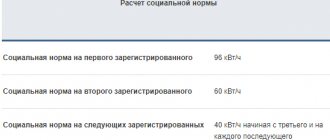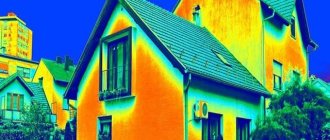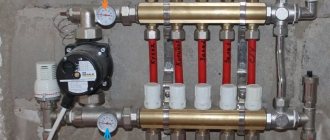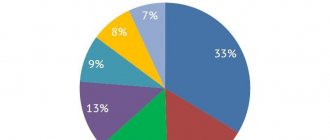Utility tariffs are increasing monthly. The tariff for heat energy is growing especially noticeably. You can figure out how to pay for sewerage and water yourself and check whether the calculation was made correctly for you. But calculating the cost of heating is not so simple. Residents are concerned about the issue of paying for heat, since in neighboring houses residents receive receipts with different numbers. To avoid being deceived, it is better to understand the heat energy calculation system yourself and check the data monthly. Our article will consider heat payment standards, as well as heat energy calculations.
What determines the weather in your home?
Modern equipment allows you to maintain hot water supply standards to heating radiators without much human intervention. But the number on the device is one thing, but the actual heat in the apartment is completely different. The final result depends on many parameters:
- The climate of the area where you live. In Moscow, with its drier climate, the cold is felt less than in St. Petersburg with its dampness.
- Thermal conductivity of the structure. Houses built of brick have lower thermal conductivity than block houses. As a result, the temperature of the water in the heating radiators may be lower due to less heat loss.
- Location of the apartment in the house. Corner rooms freeze more than apartments located in the center of the house. Heat loss in heating radiators will be greater.
- Decoration Materials. Walls covered with heat-saving wallpaper retain heat longer. This reduces heat loss from radiators and central heating radiators.
- Heating radiator material. Cast iron batteries give off less heat than steel ones.
Temperature standards in external networks
All these indicators will affect the atmosphere in the house regardless of the heating temperature standards. It also doesn’t matter how hot the radiators or radiators in the apartment are.
Energy
How to calculate energy costs with your own hands, knowing the heat consumption?
It is enough to know the calorific value of the corresponding fuel.
The easiest way is to calculate the energy consumption for heating a house: it is exactly equal to the amount of heat produced by direct heating.
An electric boiler converts all consumed electricity into heat.
Thus, the average power of an electric heating boiler in the last case we considered will be equal to 4.33 kilowatts. If the price of a kilowatt-hour of heat is 3.6 rubles, then we will spend 4.33*3.6=15.6 rubles per hour, 15*6*24=374 rubles per day, and so on.
It is useful for owners of solid fuel boilers to know that firewood consumption rates for heating are about 0.4 kg/kWh. Coal consumption rates for heating are half as much - 0.2 kg/kWh.
Coal has a fairly high calorific value.
Thus, in order to calculate the average hourly consumption of firewood with your own hands at an average heating power of 4.33 kW, it is enough to multiply 4.33 by 0.4: 4.33 * 0.4 = 1.732 kg. The same instructions apply to other coolants - just look in the reference books.
Standard heating consumption per sq. m.
hot water supply
1 2 3
1.
Multi-apartment residential buildings equipped with centralized heating, cold and hot water supply, drainage with showers and baths
Length 1650-1700 mm 8.12 2.62
Length 1500-1550 mm 8.01 2.56
Length 1200 mm 7.9 2.51
2.
Multi-apartment residential buildings equipped with centralized heating, cold and hot water supply, drainage with showers without bathtubs
7.13 2.13 3. Multi-apartment residential buildings equipped with centralized heating, cold and hot water supply, drainage without showers and baths 5.34 1.27
4.
Heating consumption standard for MKD
Next, we will consider what the consumption standard established for heating is and how it is formed.
Based on Rules 354, the quality of heating is assessed taking into account changes in air temperature in the room.
The coolant (usually water) is heated to a predetermined temperature and circulates in the heating system.
Heat from the coolant enters the atmosphere, as a rule, thanks to heating radiators.
Standards for the consumption of utilities in Moscow
| No. | Name of company | Tariffs including VAT (rubles/cubic m) | |
| cold water | drainage | ||
| 1 | JSC "Mosvodokanal" | 35,40 | 25,12 |
Note. Tariffs for cold water and sewerage for the population of the city of Moscow do not include commission fees charged by credit institutions and payment system operators for services for accepting these payments.
Heating standards per 1 square meter
It should be remembered that you do not need to make calculations for the entire apartment, because each room has its own heating system and requires an individual approach. In this case, the necessary calculations are made using the formula: C*100/P=K, where K is the power of one section of your radiator battery, as stated in its characteristics; C is the area of the room.
Basic standards for thermal energy consumption for heating
In most cases, the wear and tear of urban heating networks is to blame, during which the generated energy partially goes into the air.
https://www.youtube.com/watch?v=Yoq13EYaDe4
Be that as it may, heating standards are not observed, so consumers have every right to file a corresponding complaint and demand a recalculation of tariff plans. The choice of one or another calculation method depends on whether a heat meter is installed in the house or apartment.
In the absence of a general house meter, tariffs are calculated according to standards, and those, as we have already found out, are determined by local authorities.
This is done through a special decree, which also determines the payment schedule - whether you will pay all year round or exclusively during the heating season.
What are the standards for the consumption of utilities in Moscow in 2022?
No. 41 “On the transition to a new system of payment for housing and utilities and the procedure for providing housing subsidies to citizens”, the indicator for heat supply applies:
- heat energy consumption for heating the apartment – 0.016 Gcal/sq. m;
- water heating – 0.294 Gcal/person.
Residential buildings equipped with sewerage, running water, baths with hot central water supply:
- water disposal - 11.68 m³ per person per month;
- hot water – 4.745.
- cold water – 6.935;
Housing equipped with sewerage, running water, baths with gas heaters:
- water disposal – 9.86;
- cold water – 9.86.
Houses with running water with gas heaters near the bathtubs and sewerage:
- 9.49 m³ per 1 person per month.
- 9,49;
Residential buildings of hotel type, equipped with running water, hot water supply, gas:
- cold water – 4.386;
- hot – 2,924.
- water disposal – 7.31;
Utility consumption standards
Payment for electricity, water supply, sewerage and gas is made according to established standards if an individual meter is not installed.
- From July 1 to December 31, 2015 – 1.2.
- From January 1 to June 30, 2022 – 1.4.
- From July 1 to December 31, 2022 – 1.5.
- From 2022 – 1.6.
- From January 1 to June 30, 2015 – 1.1.
Thus, if you do not have a collective heat meter installed in your house, and you pay, for example, 1 thousand rubles a month for heating, then from January 1, 2015 the amount will increase to 1,100 rubles, and from 2022 - to 1,600 rubles
Calculation of heating in an apartment building from 01/01/2019
The calculation methods and examples presented below provide an explanation of the calculation of the heating fee for residential premises (apartments) located in apartment buildings with centralized systems for supplying thermal energy.
How to calculate the heating system of a house?
In the process of developing a heating system project, the thermal performance of the batteries is considered one of the important factors. This is necessary in order to guarantee the temperature required by the sanitary standards of the Russian Federation in the middle of the living room from +22 ° C. But the devices differ from each other not only in the material of manufacture, size, but also in the amount of heat energy released per 1 square meter. m. Thanks to this, calculations of heating devices are made before purchasing.
Where to start
A suitable indoor climate for living is ensured by correctly selected heating devices. The manufacturer attaches a passport with technical properties to each product. It indicates the power of any type of heating device, based on the size of one part or block. This information is important for calculating the dimensions of the unit, their quantity, taking into account some other factors.
From SNiP 41-01-2003 it is known that the heat flow entering the rooms and kitchens must be taken no less than 10 W per 1 m2 of floor, in other words, the calculation of the heating system of a privatized house is simple - you need to take the rated power of the battery, think about the apartment area and count the number of heating devices. But everything is much more problematic: it is selected not by square meters, but by this parameter, like thermal loss. Causes:
1. The task of the heating structure is to compensate for the heat loss of the home and raise the temperature in the middle to a comfortable one. Heat escapes most energetically through window openings and cold walls. At the same time, a house that is warm according to the rules and without drafts requires much lower power heating devices.
2. The calculation includes:
- ceiling height;
- region of residence: the average street temperature in Yakutia is -40 °C, in Moscow – -6 °C. Naturally, the size and power of heating devices must be different;
- ventilation unit;
- composition and thickness of fencing structures.
Having received the given value, we begin to calculate the main indicators.
How to correctly calculate the power and number of sections
Sellers of heating equipment like to look at the average values indicated in the instructions for the device. In other words, if it is noted that 1 section of an aluminum battery can warm up to 2 sq. m of space, then auxiliary calculations are not needed, but this is absolutely not true. During the tests, conditions are taken that are close to perfect: the inlet temperature is not less than +70 or +90 °C, the return temperature is +55 or +70 °C, the internal temperature is +20 °C, the insulation of the fencing structures complies with SNiPs. In reality the situation is very different.
- Rare CHP plants maintain a stable temperature, the required 90/70 or 70/55.
- Boilers used to heat a privatized house do not provide more than +85 °C, so by the time the coolant reaches the heating device, the temperature drops another couple of degrees.
- Aluminum batteries have the highest power – up to 200 W. However, they cannot be used in a centralized system. Bimetallic - approximately 150 W, cast iron - up to 120.
Gas consumption by the boiler for heating 1 sq. m. / year in the apartment.
1. Calculation by area.
In various sources you can find how much the simplest calculation of the power of heating batteries per square meter is too heavy with the inclusion of logarithmic purposes. The first is based on the theorem: 1 m2 of floor requires 100 W of heat. The indicator must be multiplied by the area of the room, and the required operating intensity of the heating device is obtained. The value is divided by the power of 1 part - the required number of segments is found.
There is a 4 x 5 room, Global bimetallic radiators with a 150 W segment. Power = 20 x 100 = 2,000 W. Number of sections = 2,000 / 150 = 13.3.
Calculation of the number of bimetal radiator sections shows that for this example 14 nodes are needed. An impressive accordion will fit under the window. It is clear that this technique is very symbolic. First of all, the volume of the room, thermal losses through the facade walls and window openings are not taken into account. Secondly, the “100 to 1” indicator is the result of a complex but outdated engineering thermal calculation for a specific type of structure with strict parameters (dimensions, thickness and material of partitions, insulation, roofing, and so on). For many homes, the rule will not work, and the result of its use will be insufficient or excessive heating (depending on the degree of insulation of the house). To check the accuracy of calculations, let's take some difficult calculation techniques.
2. Calculation of heat losses.
The calculation formula includes average correction factors and is expressed as follows:
Q = (22 + 0.54Dt)(Sp + Sns + 2So), where:
- Q – required heat output from heating devices, W;
- Dt – difference between the indoor air temperature and the calculated outdoor temperature, degrees;
- Sp – floor area, m2;
- Sns – external wall dimensions, m2;
- So – area of window openings, m2.
- X=Q/N
- where Q is the heat loss of the room;
- N – power of 1 segment.
There is a room 4 x 5 x 2.5 m, window opening 1.2 x 1, one wall outside, Global bimetallic radiators with a power of some 150 W. The thermal conductivity index according to SNiP is 2.5. Ambient temperature – -10 °C; in the middle – +20 °С.
- Q = (22 + 0.54 x 30) x (20 + 10 + 2.4) = 1237.68 W.
- Number of sections = 1237.68 / 150 = 8.25.
We round up to the nearest whole number and get 9 sections. You can check with an additional calculation option with climate coefficients.
3. Calculation of room heat losses according to SNiP “Building Climatology” 01/23/99.
First, you need to determine the level of thermal loss of the room through the walls located inside and outside. This indicator is calculated separately for window and door openings.
Q = F x kthermal conductivity x (tin-tout), where:
- F – area of external fences minus window openings, m2;
- k – taken according to SNiP “Building climatology” 01/23/99, W/m2K;
- tin – temperature in the middle of the room, approximately the value is taken from +18 to +22 °C;
- tnar – outside air temperature, the value is taken from the same SNiP or from the resource of the city’s meteorological service.
The results obtained for walls and openings are added up, and the total amount of heat loss is obtained.
There is a room 4 x 5 x 2.5 m, window opening 1.2 x 1, one wall outside, Global bimetallic radiators with a power of some 150 W. The thermal conductivity index according to SNiP is 2.5. Each window takes about 100 W, the door - 150.
- Qwalls internal = 10 x 2.5(20 + (-10)) = 250.
- Qouter walls = 8.8 x 2.5 (20 + (-10)) = 220.
- Total heat loss = 250 x 3 + 220 + 100 + 150 = 1,080 W.
- Number of sections = 1,220 / 150 = 8.13.
Almost the same result, but that’s not all. Correct calculation of heating batteries for a house or apartment includes an adjustment to the actual power of the heating device under specific conditions (water supply, return and air temperatures). The indicator does not depend on the version of the heating device; it is a mathematical component. Most manufacturers, for example, Kermi, Fondital, send dealers a specialized table of coefficients that allow you to adjust the nominal heating capacity and obtain the actual one, taking into account the current temperature of the coolant and air in the area of residence.
If you do not have access to similar information, you can add to the calculated value a 20% power reserve in case of extreme cold. Similarly, the number of sections increases to 10 pieces.
Online calculator Your browser does not support floating frames!
What determines the number of heating devices in a room?
Heating devices are a priori installed where it is coldest - under or next to window openings on the external wall, in other words, the first and main factor is the area of greatest heat loss. If there are 2 window openings, then it makes more sense to install batteries under each.
Another condition is the material from which the device is made. The higher the thermal conductivity, the smaller the heating device. For our example, in terms of metal Global Evolution 203 W, you will need 8 sections, if you take cast iron Cherad 97 W - 16 pieces.
The location of the apartment or house is no less important. The corner room is always colder - two walls face the street. If the coolant moves from top to bottom, the return increases by 20%. Wall and floor insulation plays a big role here - the standard value of 0.024 W/m2K improves the thermal capacity of the room by almost 40%. Installation of double or triple glazed windows reduces heat loss by 20%. In contrast, vigorous mechanical ventilation requires increased power.
How to pay less
Studies have shown that apartments in multi-storey buildings unprepared for the heating season lose almost 40% of the heat generated by radiators of central and autonomous networks. This means that residents pay for heating the atmosphere, but not the apartment.
To reduce resource leakage and heating fees, it is recommended to fulfill the following conditions:
- Install a heat meter, preferably a common one and an individual one. This will allow you to keep control over your consumption.
- Metal-plastic windows retain heat in an apartment more reliably than those with wooden frames. But the first ones need to be looked after and before the start of the heating season, call a specialist for preventive procedures and adjusting the frames. This saves up to 20% money and heat.
- A glazed balcony will also protect against waste of valuable service. A loggia that is tightly closed in winter prevents 10% of the heat from escaping to the street.
- Modern-type radiators contribute to a greater transfer of heat energy to the room than old cast-iron radiators, even with the same utility supply.
- The thermostats installed on new radiators will not allow the apartment owner to heat the non-residential area. By covering a temporarily empty room, you can save some money.
- The biggest losses occur through the walls and ceiling. If you insulate them, then almost half of the heat received will remain in the room. For this purpose, blocks made of mineral wool, expanded polystyrene, and other materials are used.
The last resort is the most expensive, but it will reduce heating bills and improve the quality of heating.
Every resident can calculate the amount of contribution in an apartment or private house. You just need to install collective and individual heat meters. Metering devices will allow you to save the heat energy received and avoid the multiplying factor added in the absence of meters. You should not forget about insulating your home.
Watch the video: “Free heating course.”
Free consultation by phone! Moscow and region: ; St. Petersburg and region:
Specifics and other features
It is also possible that the premises for which the calculation is being made may have other specific features; not all of them are similar or exactly the same. These could be indicators such as:
- the coolant temperature is less than 70 degrees – the number of parts must be increased accordingly;
- absence of a door in the opening between two rooms. Then you need to calculate the total area of both rooms in order to calculate the number of radiators for optimal heating;
- Double-glazed windows installed on windows prevent heat loss, therefore, fewer battery sections can be installed.
When replacing old cast iron batteries. which ensured normal temperature in the room, for new aluminum or bimetallic ones, the calculation is very simple. Multiply the heat output of one cast iron section (average 150 W). Divide the result by the amount of heat of one new part.
How to calculate consumed thermal energy
If for one reason or another there is no heat meter, then to calculate thermal energy you must use the following formula:
Let's look at what these symbols mean.
1. V denotes the amount of hot water consumed, which can be calculated either in cubic meters or in tons.
2. T1 is the temperature indicator of the hottest water (traditionally measured in the usual degrees Celsius). In this case, it is preferable to use exactly the temperature that is observed at a certain operating pressure. By the way, the indicator even has a special name - enthalpy. But if the required sensor is missing, then as a basis you can take the temperature regime that is extremely close to this enthalpy. In most cases, the average is approximately 60-65 degrees.
3. T2 in the above formula also denotes the temperature, but of cold water. Due to the fact that it is quite difficult to penetrate the main line with cold water, constant values are used as this value, which can change depending on the climatic conditions outside. So, in winter, when the heating season is in full swing, this figure is 5 degrees, and in the summer, when the heating is turned off, 15 degrees.
4. As for 1000, this is the standard coefficient used in the formula in order to obtain the result in gigacalories. It will be more accurate than if you used calories.
5. Finally, Q is the total amount of thermal energy.
As you can see, there is nothing complicated here, so we move on. If the heating circuit is of a closed type (and this is more convenient from an operational point of view), then the calculations must be made slightly differently. The formula that should be used for a building with a closed heating system should look like this:
Now, accordingly, to the decoding.
1. V1 indicates the flow rate of the working fluid in the supply pipeline (typically, not only water, but also steam can act as a source of thermal energy).
2. V2 is the flow rate of the working fluid in the return pipeline.
3. T is an indicator of the temperature of a cold liquid.
4. T1 – water temperature in the supply pipeline.
5. T2 – temperature indicator that is observed at the outlet.
6. And finally, Q is the same amount of thermal energy.
It is also worth noting that the calculation of Gcal for heating in this case depends on several notations:
- thermal energy that entered the system (measured in calories);
- temperature indicator during the removal of working fluid through the return pipeline.
Requirements for heat supply systems
The legislation of the Russian Federation imposes sanitary, epidemiological and fire safety requirements for heating systems. For safety reasons, heating devices comply with SanPin and SNiP regulations.
We talked more about the rules for organizing heat supply in a separate article.
Hygienic
When installing heating systems, optimal indoor microclimate conditions and air quality are taken into account.
Hygienic requirements are regulated and governed by the following conditions:
- no odor;
- uniform air distribution;
- no toxic emissions during operation;
- accessibility for repairs, cleaning and maintenance;
- absence of noise (what are the causes of noise in radiators?).
The temperature does not exceed 90 degrees. Systems heating above 75 degrees are equipped with protective guards. The concentration of chemicals in the air during operation of heat supply systems does not exceed the established safe exposure level.
Fire protection
Fire safety requirements for the construction and operation of heating systems in apartment buildings are regulated by SP 60.13330.2012. For safety reasons, hot water or steam is used as a coolant. In climatic regions with low temperatures, non-explosive substances are used to prevent the liquid from freezing.
In apartment buildings with a height of more than 9 floors, the installation of heat generators operating on gaseous fuel is allowed. Gas supply systems are equipped with automatic systems that shut off the supply of fuel in emergency situations. According to the standards, heat generators are installed in apartments that produce no more than 35 kW of heat. The total heating output does not exceed 100 kW.
What is Gcal
We should start with a related definition. A calorie refers to the specific amount of energy required to heat one gram of water to one degree Celsius (at atmospheric pressure, of course). And due to the fact that from the point of view of heating costs, say, at home, one calorie is a tiny amount, gigacalories (or Gcal for short), corresponding to one billion calories, are used for calculations in most cases. We've decided on this, let's move on.
The use of this value is regulated by the relevant document of the Ministry of Fuel and Energy, published back in 1995.
Note! On average, the consumption standard in Russia per square meter is 0.0342 Gcal per month. Of course, this figure may vary for different regions, since everything depends on climatic conditions
So, what is a gigacalorie if we “transform” it into values that are more familiar to us? See for yourself.
1. One gigacalorie is equal to approximately 1,162.2 kilowatt-hours.
2. One gigacalorie of energy is enough to heat a thousand tons of water to +1°C.
Calculation of the number of sections of heating radiators - why you need to know this
At first glance, it’s easy to calculate how many sections of a heating device to install in a particular room. The larger the room, the more sections the heating device should consist of. But in reality, how warm it will be in a particular room depends on more than a dozen factors. Taking them into account, it is possible to calculate the required amount of heat from heating devices several times more accurately.
General information
The heat output of one part of a cast iron radiator is 140 watts, higher quality iron ones are from 170 and above.
You can calculate the number of sections of heating radiators based on the area of the room or its volume.
According to standards, it is believed that 100 watts of heat energy is needed to heat one meter square room. If we proceed from the volume, then the amount of heat per 1 cubic meter will usually be no less than 41 watts.
But none of these options will be accurate if you do not keep in mind the properties of a particular room, the number and window size, wall material, and much more. Thanks to this, when calculating the parts of a heating device using a standard formula, we will begin to add the coefficients made by one or another requirement.
Room area - calculation of the number of sections of heating radiators
A similar calculation in most cases applies to rooms located in standard panel residential buildings with a ceiling height of up to 2.6 meters.
The area of the room is multiplied by 100 (the amount of heat for 1m2) and divided by the heat output of one part of the heating device indicated by the manufacturer. For example: the area of a room is 22 m2, the heat output of one part of the heating device is 170 watts.
For this room, 13 sections of the heating device are required.
If one section of the heating device begins to have 190 watts of heat output, then we get 22X100/180 = 11.57, in other words, you can get by with 12 sections.
It is necessary to add 20% to the calculations if the room has a balcony or is located in the section of the house. A battery placed in a niche will reduce heat transfer by another 15%. However, the kitchen will be 10-15% warmer.
We make calculations based on the volume of the room
For a house made of panels with a normal ceiling height, as mentioned above, the thermal calculation is based on the need for 41 watts per 1m3. But if, for example, the house is new, brick, glass packages are installed in it, and the facade walls are insulated, then 34 watts per 1 m3 are already needed.
The formula for calculating the number of sections of a heating device is as follows: the volume (area multiplied by the ceiling height) is multiplied by 41 or 34 (depending on the type of house) and divided by the heat output of one part of the heating device installed in the manufacturer’s passport.
Room area 18 m2, ceiling height 2.6 m. The house is a stereotypical panel building. The heat output of one part of the heating device is 170 watts.
18X2.6X41/170=11.2. So, we need 11 sections of the heating device. This is provided that the room is not corner and does not have a balcony; otherwise, it is better to install 12 sections.
Let's calculate as accurately as possible
And here is the formula by which you can most accurately calculate the number of sections of a heating device:
The area of the room multiplied by 100 watts and by the coefficients q1, q2, q3, q4, q5, q6, q7 and divided by the heat output of one part of the heating device.
Details about these coefficients:
q1 – type of glazing: with triple glazing the indicator will be 0.85, with double glazing - 1 and with single glazing - 1.27.
q2 – thermal insulation of walls:
- modern thermal insulation – 0.85;
- laying in two bricks using insulation – 1;
- non-insulated walls - 1.27.
q3 – ratio of window and floor areas:
q4 - lowest external temperature:
- -10 degrees – 0.7;
- -20 degrees – 1.1;
- -35 degrees – 1.5.
q5 – number of façade walls:
q6 – type of room that is located above the calculated one:
- heated - 0.8;
- heated attic - 0.9;
- unheated attic – 1.
q7 – ceiling height:
If all the above coefficients are taken into account, it will be possible to calculate the number of sections of the heating device in the room as accurately as possible.
Computations
It is almost impossible to calculate the exact value of heat loss for an arbitrary building. However, methods for approximate calculations have long been developed that give fairly accurate average results within the limits of statistics. These calculation schemes are often referred to as calculations based on aggregated indicators (meters).
Along with thermal power, there is often a need to calculate daily, hourly, annual thermal energy consumption or average power consumption. How to do it? Let's give a few examples.
Hourly heat consumption for heating using enlarged meters is calculated using the formula Qot=q*a*k*(tin-tno)*V, where:
- Qot - the desired value in kilocalories.
- q is the specific heating value of the house in kcal/(m3*S*hour). It is looked up in directories for each type of building.
The specific heating characteristic is tied to the size, age and type of building.
- a is the ventilation correction factor (usually 1.05 - 1.1).
- k is the correction factor for the climatic zone (0.8 - 2.0 for different climatic zones).
- tin - internal temperature in the room (+18 - +22 C).
- tno - street temperature.
- V is the volume of the building together with the enclosing structures.
To calculate the approximate annual heat consumption for heating in a building with a specific consumption of 125 kJ/(m2*S*day) and an area of 100 m2, located in a climate zone with the GSOP=6000 parameter, you just need to multiply 125 by 100 (house area ) and by 6000 (degree days of the heating period). 125 * 100 * 6000 = 75,000,000 kJ, or approximately 18 gigacalories, or 20,800 kilowatt-hours.
To recalculate the annual consumption into the average thermal power of heating equipment. it is enough to divide it by the length of the heating season in hours. If it lasts 200 days, the average heating power in the above case will be 20800/200/24=4.33 kW.
Heat calculation rules
To determine the amount of heat supplied, three different formulas are used; they are presented in Appendix of Resolution No. 354. They are used for the following cases:
- There are no metering devices in the building (there is neither a general nor an individual heat consumption meter), and they cannot be installed due to the design features of the heating system or other objective reasons. The formula is as follows: Pi = Si x NT x T t, where Pi is the fee, Si is the housing area, NT is the established standard for thermal energy consumption, and T t is the accepted tariff. For example, if the housing has an area of 45 sq. meters, the region has adopted a standard of 0.018 gigacalories per 1 sq. m., and the tariff is 1950 rubles per 1 gigacalorie, the owner will have to pay 1579.50 rubles if only the period of operating heating is paid.
- A common meter (GPU) is installed in the house, but individual metering devices are missing or not installed in all rooms. The formula is as follows: where V d is the reading of the general building meter, Si is the area of a specific apartment, Sob is the total area of premises in the building, and T T is the current tariff. For example, if a common household device counts 170 gigacalories per month, the area of an apartment is 45 sq.m., the total area of premises in an apartment building is 7100 sq.m., and the regional tariff is 1950 rubles per gigacalorie, then after calculation using the formula the owner will have to pay 2101, 06 rubles. Heat calculations are taken into account only for the heating season.
- The house has both OPU and IPU installed. The calculation formula is as follows: . It contains Vi n - the readings of individual or general metering devices, - heat costs for general house needs, - the area of the apartment, - the total area of the premises, - the established tariff.
Using the last formula, the calculation will be carried out as follows. For example, an apartment meter for a month of heating showed 1.2 Gkl, a common building meter - 65 Gkl, all the heating units in the house showed a total of 53 Gkl. 65 – 53 = 12 Gkl – consumption for general house needs. The total area of premises in the house is 6000 sq.m., the area of the apartment is 62 sq.m. In the region, the tariff is 1600 rubles. for 1 Gkl. After calculating using the formula, it turns out that in just one month of the heating season, the apartment owner will pay 2118.40 rubles.
The management company is required to measure the supplied heat energy monthly using installed meters. But the energy supplier determines the monthly payment once a year.











